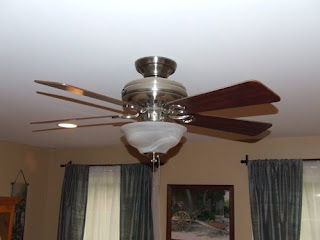How To Replace Light Fixture with Ceiling Fan
 Replacing a light fixture with a ceiling fan is a great way to cool down a room and lower your electric bill this summer. However, installing ceiling fans in existing construction can sometimes be a challenge. Ceiling fans require a special heavy duty ceiling fan junction box to support their heavy weight.
Replacing a light fixture with a ceiling fan is a great way to cool down a room and lower your electric bill this summer. However, installing ceiling fans in existing construction can sometimes be a challenge. Ceiling fans require a special heavy duty ceiling fan junction box to support their heavy weight.
Before you start any electrical project make sure you shut off the electricity to the circuit you’re working on. Then make sure you test the circuit to make sure it’s in fact de-energized. Next you’ll want to remove the existing light fixture and existing electrical junction box. Most light fixtures will not be installed in a proper fan junction box. If you’re not sure then remove and get rid of the existing junction box. Typically a normal light fixture box will be mounted to the side of a ceiling joist. Once you remove the existing junction box you’ll be able to verify that.
If the existing junction box was attached to the side of the ceiling joist then you’ll want t o buy a pancake shallow ceiling fan junction box (see photo). Place the pancake box on the ceiling centered over the ceiling joist (you should be able to do this by looking into the hole left from the previous box) and trace the circular shape with a pencil. Now cut out the drywall or plaster in the circular shape to expose the joist (or strapping if present). Now you can screw the pancake box directly to the ceiling joist (I’d use at least two 3″ long screws) and pull the existing wires into the new box.
o buy a pancake shallow ceiling fan junction box (see photo). Place the pancake box on the ceiling centered over the ceiling joist (you should be able to do this by looking into the hole left from the previous box) and trace the circular shape with a pencil. Now cut out the drywall or plaster in the circular shape to expose the joist (or strapping if present). Now you can screw the pancake box directly to the ceiling joist (I’d use at least two 3″ long screws) and pull the existing wires into the new box.
Next you’ll need to patch the hole left from the previous junction box (I’ll assume for now that you can figure this step out or read about patching drywall elsewhere). Once the ceiling is patched and painted you can install the ceiling fan according to the manufactures directions. Most likely in this scenario you’ll only have a single feed to you’ll have to switch the light and fan on with the switch and control the functions with pull chains.
The most important thing to remember here is that you should not install a ceiling fan in an existing electrical junction box that’s not rated for a fan. You can cause serious damage or injury to yourself or family if you do. Also make sure you understand and follow all electrical codes.
If you enjoyed this post and you’d like to read about why fans make the Green Grade over air conditioners then check out my post over at Today’s Green Construction.













I so want a ceiling fan… but my 6’4″ husband has put a moratorium on them until we get a house with ceilings that aren’t 8 feet. :) Looks like we’ll be raising the ceilings sometime soon (back to their original height).
I’m 6’4″…8′ ceilings in this house….maybe he should reconsider…they really don’t bother me one bit!
Good article, Todd. Home Depot and Lowes also sell a box with extender arms that will reach out and pierce the joists on both sides to hold it firmly in place if you are trying to get the box to hang in the middle of the room and there’s no joist perfectly in the middle. Our electrician at the prior house used those when he refinished ours.
Of course, if you have attic access to the room, you can just block between the joists and use your method.
We’re considering a fan for our bedroom, but since we have 7’6″ ceilings, it will be a low profile version without lights, and we’ll put in recessed lights around it.
Be careful installing recessed lighting behind a ceiling fan. The lights must be set wider than the fan blades in order to avoid strobing. It may seem obvious, but when the fans are suspended the cone of unacceptable lighting placement is quite wide. There must be NO PLACE IN THE ROOM where you have a direct line of sight to the light through the fan circle.